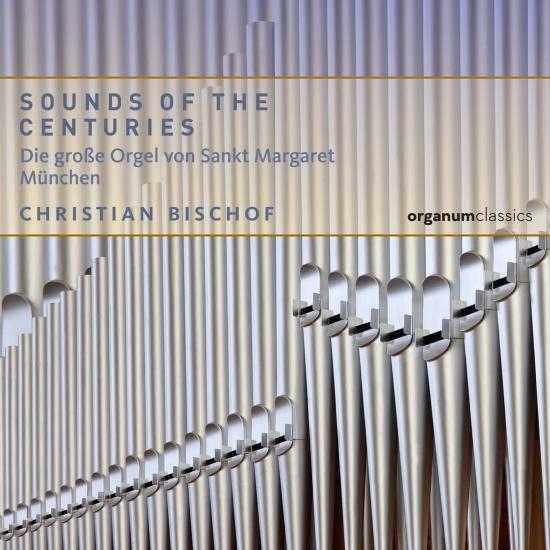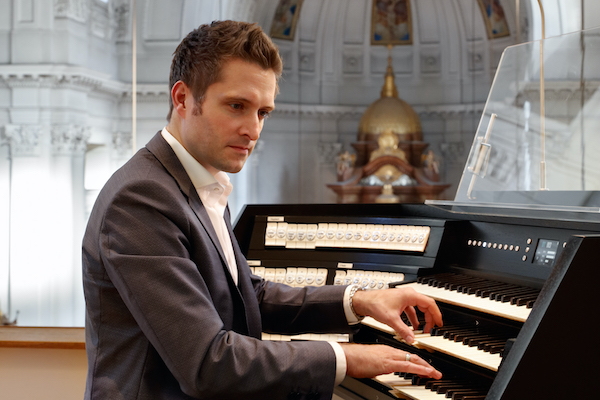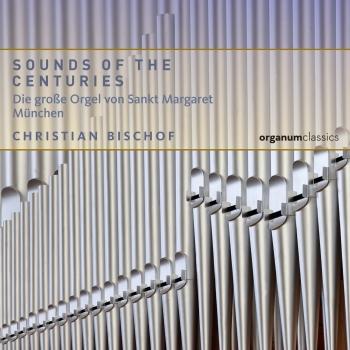
Sounds of the Centuries. Die große Orgel der Pfarrkirche St. Margaret München Christian Bischof
Album info
Album-Release:
2021
HRA-Release:
22.01.2021
Label: Organum Classics
Genre: Classical
Subgenre: Chamber Music
Artist: Christian Bischof
Composer: Johann Sebastian Bach, Felix Mendelssohn-Bartholdy, Max Reger, Richard Wagner, Gabriel Fauré, Olivier Messiaen, Naji Subhy Hakim, Louis Vierne
Album including Album cover Booklet (PDF)
- Johann Sebastian Bach (1685-1750):
- 1Bach: Toccata et fuga in d, BWV 56509:46
- Felix Mendelssohn Bartholdy (1809-1847):
- 2Bartholdy: Ouvertüre aus dem Oratorium Paulus, MWV A 14. Paraphrase über den Choral "Wachet auf!", ruft uns die Stimme07:58
- Max Reger (1873-1916):
- 3Reger: Ave Maria Des-Dur, Op. 80 Nr. 5 aus Zwölf Stücke04:04
- 4Reger: Phantasie über den Choral "Wie schön leucht't uns der Morgenstern", Op. 40 Nr. 119:31
- Olivier Messiaen (1908-1992):
- 5Messiaen: La vierge et l'enfant (Die Jungfrau und das Kind). Meditation I aus La Nativité du Seigneur06:38
- Richard Wagner (1813-1883), Sigfrid Karg-Elert (1877-1933):
- 6Wagner: Festmusik aus den Meistersingern. Nr. 8 aus dem Richard Wagner Album. 18 Konzertbearbeitungen für Orgel06:06
- Gabriel Fauré (1845-1924):
- 7Fauré: Sicilienne aus der Orchestersuite Pelléas et Mélisande, Op. 8003:53
- Naji Subhy Hakim (b. 1955):
- 8Hakim: Te Deum09:07
- Louis Vierne (1870-1937):
- 9Vierne: Clair de lune (Mondglanz, Mondschein), Op. 53 Nr. 5 aus 24 Pièces de Fantaisie. Deuxième Suite09:16
- 10Vierne: Carillon de Westminster (Das Glockenspiel von Westminster), Op. 54 Nr. 6 aus 24 Pièces de Fantaisie. Troisième Suite07:19
Info for Sounds of the Centuries. Die große Orgel der Pfarrkirche St. Margaret München
Sounds of the centuries – organ music from four centuries
The present programme is framed, on the one hand, by one of the most popular of all organ works – Johann Sebastian Bach’s Toccata and Fugue in D minor – and, on the other, by the melody of the world’s most famous chimes, Louis Vierne’s Carillon de Westminster. Between these two works Christian Bischof performs a wide range of other pieces for his first solo album. All of them serve to showcase the orchestral sonorities of the organ at Sankt Margaret, sonorities that extend from an ethereally delicate whisper to subtly differentiated and full-toned mixtures, culminating in thunderous waves of sound and covering a vast spectrum of colours and dynamics.
Five of the works that feature in the present album are closely associated with the theological beliefs of the two main Christian faiths: in the pieces by Felix Mendelssohn, Max Reger and Olivier Messiaen the programmatical nucleus rests on various aspects of Advent and Christmas. Modernism finds expression in two pieces by two famous organists at Sainte-Trinité in Paris, Olivier Messiaen and Naji Hakim, both of whom draw their inspiration directly from the solemnities that are integral to the Catholic liturgy. Messiaen’s meditation “La Vierge et l’Enfant” (Virgin and Child) comes from his Christmas cycle La Nativité, symbolizing the touching tranquillity of the events surrounding Christmas and echoing Max Reger’s pictorially illustrative Morgenstern Fantasy and heartfelt Ave Maria in D flat major, while Naji Hakim’s brilliant Te Deum could be described as a response to the call “Wachet auf! ruft uns die Stimme” (Sleepers, Awake!) from Philipp Nicolai’s eponymous hymn, the melody of which is paraphrased in the Overture to Felix Mendelssohn’s St Paul.
Last but not least, Max Reger and Richard Wagner represent Munich as a centre of music with the Festival Music from The Mastersingers (arrangement for organ by Sigfrid Karg-Elert).
Two other concert works and Romantic organ transcriptions reveal other facets of Sankt Margaret’s recently renovated organ: Louis Vierne’s Clair de lune (Moonlight) and Gabriel Fauré’s Sicilienne from his orchestral suite Pelléas et Mélisande op. 80. And whenever we hear Bach’s famous D minor Toccata, do we not also hear popular arrangements of it?
The large organ in Sankt Margaret’s Parish Church in Munich
Sankt Margaret is the oldest parish in the Munich region. It lies in the Munich district of Sendling. The organ in its parish church was returned to full-time use in December 2020 following its most recent general overhaul and may again be heard at church services attended by the local congregation as well as contributing to the musical life not only of the parish but of the regional capital, too. The instrument now consists of 76 stops divided over three manuals, an auxiliary department and a pedal. Some of the pipes date back to the original organ that was installed by the Munich firm of Nenninger & Moser in 1915 (III/57). Aesthetically speaking, this instrument was designed in the main to reflect the contemporary late Romantic taste in music. A number of stops were intended by the builders to take account of the organ reforms that were then emerging in Alsace and whose ideals were first promulgated by Émile Rupp.
The organ was badly damaged by bombs in the Second World War. Although the instrument was rebuilt, attempts to maintain it proved a failure and it was finally dismantled in 1954 and replaced by a new instrument using pipes from 1915. The imposing façade of free-standing pipes was the work of Anton Schwenk & Franz Wappmansberger of Munich and Prien. The new instrument initially contained only 38 of the planned 62 stops distributed over two manuals and a pedal. It was gradually enlarged and altered over an extended period of time. The last major changes were made in 2002, when the instrument was enlarged by the local firm of Johannes Führer. By now it had 57 registers.
The present organ was built by Johannes Klais of Bonn between 2018 and 2020 and with its much wider expressive range is fully equal to the demands of the historical repertory. Its character is none the less still clearly influenced by the sound world of the German organs of the late and post-Romantic periods.
Christian Bischof, organ

Christian Bischof
The organist and conductor Christian Bischof was born in Bamberg and since 2013 has been in charge of the music in the Sankt Margaret Parish Church in Munich. In 2020 he was appointed assistant diocesan director of music, in which capacity he is responsible for training young church musicians in the Archdiocese of Munich and Freising and at the Cantorial School in Munich. His activities include head of the Diocesan St Cecilia Society in Munich-Freising, which is itself a part of the General St Cecilia Society. He is also a certified organ consultant with the Association of German Organ Consultants. Above all, he is in international demand as a concert organist.
Christian Bischof sees his musical roots in vocal music, a perspective that derives from his time at the Grammar School of the Regensburg Domspatzen (Regensburg Boys’ Choir). On leaving school, he studied Catholic church music at the University of Music in Würzburg and at the Piteå School of Music in Sweden. His main subjects here were the organ and choral conducting. During this period he also received a bursary from the Cusanus Study Foundation of the German Bishops’ Conference. He completed his studies in 2011 with a masterclass diploma in the organ. Artistically speaking, his most formative teachers were Christoph Bossert and Hans-Ola Ericsson (organ), Zsolt Gárdonyi (organ and music theory) and Jörg Straube (choral conducting). As a church musician and organist Christian Bischof has held appointments in Bamberg and Würzburg and at the Benedictine Abbey in Scheyern, on each occasion leaving a lasting mark on the institution in question. He was additionally artistic director of the Nuremberg Chamber Choir.
In 2011 Christian Bischof played a significant part in redesigning the tonal scheme of the symphonic organ in Würzburg’s St Augustine’s Church. His research on organ building in the Munich metropolitan region in the years between 1900 and 1960 focused in particular on the life and work of the organ builder Albert Moser, who was a lasting influence on the changes affecting the types of sonorities sought by German organ builders and who as a professional lived through the developments that took place in organ building between late Romanticism and the extremes of the German Organ Movement.
Christian Bischof has lectured on the organ at Würzburg’s University of Music as well as giving masterclasses and sitting on the jury at national and international competitions. Recital tours have taken him to much of Europe and also to the United States and Russia. He has given numerous recitals at conferences held by the American Guild of Organists and was artist in residence at the University of Michigan in Ann Arbor.
Christian Bischof is interested in historically informed performance practice and as a conductor enjoys working with period ensembles. His repertory as an organist covers a vast range from the earliest organ music of the Middle Ages to the modern period. His performances of works by Reger and his involvement in a performance of all of Messiaen’s organ works in Würzburg attracted international attention. His work as an organist is documented not only by CD recordings but also on various social media platforms.











